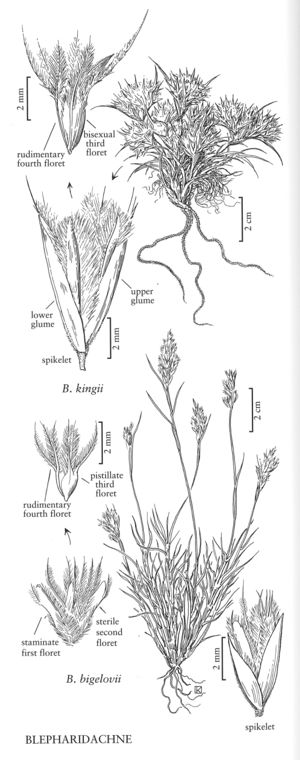Difference between revisions of "Blepharidachne kingii"
FNA>Volume Importer |
imported>Volume Importer |
||
| (8 intermediate revisions by 2 users not shown) | |||
| Line 4: | Line 4: | ||
|publications= | |publications= | ||
|common_names=King’s eyelash grass | |common_names=King’s eyelash grass | ||
| + | |special_status={{Treatment/ID/Special_status | ||
| + | |code=E | ||
| + | |label=Endemic | ||
| + | }} | ||
|basionyms= | |basionyms= | ||
|synonyms= | |synonyms= | ||
| Line 17: | Line 21: | ||
-->{{Treatment/Body | -->{{Treatment/Body | ||
|distribution=Utah;Calif.;Idaho;Nev. | |distribution=Utah;Calif.;Idaho;Nev. | ||
| − | |discussion=<p>Blepharidachne kingii grows at scattered locations in arid regions of the Great Basin, sometimes being locally abundant.</p> | + | |discussion=<p><i>Blepharidachne kingii</i> grows at scattered locations in arid regions of the Great Basin, sometimes being locally abundant.</p> |
|tables= | |tables= | ||
|references= | |references= | ||
| Line 26: | Line 30: | ||
-->{{#Taxon: | -->{{#Taxon: | ||
name=Blepharidachne kingii | name=Blepharidachne kingii | ||
| − | |||
|authority=(S. Watson) Hack. | |authority=(S. Watson) Hack. | ||
|rank=species | |rank=species | ||
| Line 33: | Line 36: | ||
|basionyms= | |basionyms= | ||
|family=Poaceae | |family=Poaceae | ||
| + | |illustrator=Linda A. Vorobik;Karen Klitz | ||
| + | |illustration copyright=Utah State University | ||
|distribution=Utah;Calif.;Idaho;Nev. | |distribution=Utah;Calif.;Idaho;Nev. | ||
|reference=None | |reference=None | ||
|publication title= | |publication title= | ||
|publication year= | |publication year= | ||
| − | |special status= | + | |special status=Endemic |
| − | |source xml=https:// | + | |source xml=https://bitbucket.org/aafc-mbb/fna-data-curation/src/200273ad09963decb8fc72550212de541d86569d/coarse_grained_fna_xml/V25/V25_79.xml |
|subfamily=Poaceae subfam. Chloridoideae | |subfamily=Poaceae subfam. Chloridoideae | ||
|tribe=Poaceae tribe Cynodonteae | |tribe=Poaceae tribe Cynodonteae | ||
Latest revision as of 17:58, 11 May 2021
Plants cespitose. Culms 3-8(14) cm. Sheaths often with a tuft of hairs at the throat, sheaths immediately below the inflorescences often spathelike; ligules to 0.5 mm; blades 0.7-3 cm long, less than 1 mm wide, strongly convolute to conduplicate, stiffly arcuate, often deciduous. Panicles 10-25 mm, subcapitate, usually partially included in the 2 spathelike upper leaf sheaths. Spikelets 6-9 mm. Glumes exceeding the florets, papery and translucent, scabridulous toward the base, acuminate or awn-tipped, awns to about 1.3 mm; lower glumes 6-7.5 mm; upper glumes 6.8-8.5 mm; lowest 2 florets usually sterile; lemmas of sterile florets 3.4-5.8 mm, lateral lobes 2.2-3 mm; paleas of sterile florets linear, plumose; third florets bisexual; third lemmas with lateral lobes 0.5-1.5 mm, awned, central awns 3-5 mm; paleas of third florets subequal to slightly longer than the lemmas; anthers 2(1), about 1.5 mm. Caryopses about 2 mm, compressed. 2n = 14.
Distribution
Utah, Calif., Idaho, Nev.
Discussion
Blepharidachne kingii grows at scattered locations in arid regions of the Great Basin, sometimes being locally abundant.
Selected References
None.
